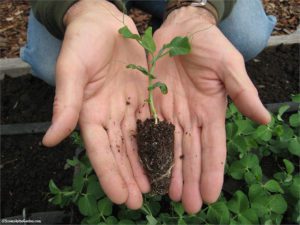9 Transplanting Tips for Success

Now that the weather is improving, we’ll all soon be planting our tender annuals and vegetables. How about some transplanting tips so your plants get off to the best possible start?
I’ve been watching the weather forecasts closely, and I’m not seeing any low temperatures in the 30s starting today, but as always, a gardener really needs to keep an eye on the weather and be ready to cover these plants if necessary.
Here goes:
- Did you “harden off” your seedlings? This should be done over several days prior to transplanting. Here’s how it works: on day 1, set the plants outside where they’re protected from the wind and where the light is filtered; they’ll stay out for just 1 hour. On day 2, they go out for 2 hours. On day 3, it’s for 3 hours and perhaps in a bit more sun. And so on… This acclimates the plants to the weather and especially to the intensity of the sunlight. At the end of 6 or 7 days, they are totally ready to face the world!
- If possible, choose an overcast day for transplanting. That way, the sun isn’t as intense, which will make it easier on your plant babies.
- Before you even get ready to transplant your seedlings, water them well. Plants that start off with dry soil in their pots are much more likely to experience “transplant shock.”
- Be sure to water the bed(s) you’ll be transplanting them into well. This is for the exact same reason as #3. If the soil in your bed(s) is dry, it will wick the water right out of the newly-transplanted seedlings’ root balls. Not good!
- When planting your seedlings, do not pull them out of their pots by their stems. This crushes the cells in the stems, which can either kill the plants or adversely affect their ability to transport moisture and nutrients from the roots to the leaves. For seedlings that are in small-celled flats, I like to use a slot screwdriver to slip in next to the outside of each root ball and gently lift them up out of their cell.
- Once the plant is in its hole, gently press the soil around the root system to eliminate any air pockets around the roots. This is so important!
- And finally, water them in again. This will further settle the soil around the roots and also re-hydrate the plants.
- For your heat-loving veggie plants (melons, cucumbers, winter squash, eggplants and tomatoes), consider covering them with a sheet of floating row cover for about 2 weeks. This will keep them just a little bit toastier, which will make them so happy.
- In about a few days, feed them with diluted fish fertilizer. For example, mix 2 tablespoons of fish emulsion with 1 gallon of water. This provides the plants with nitrogen and gives them a bit of a jump-start!
OK, everybody: go forth and plant!

